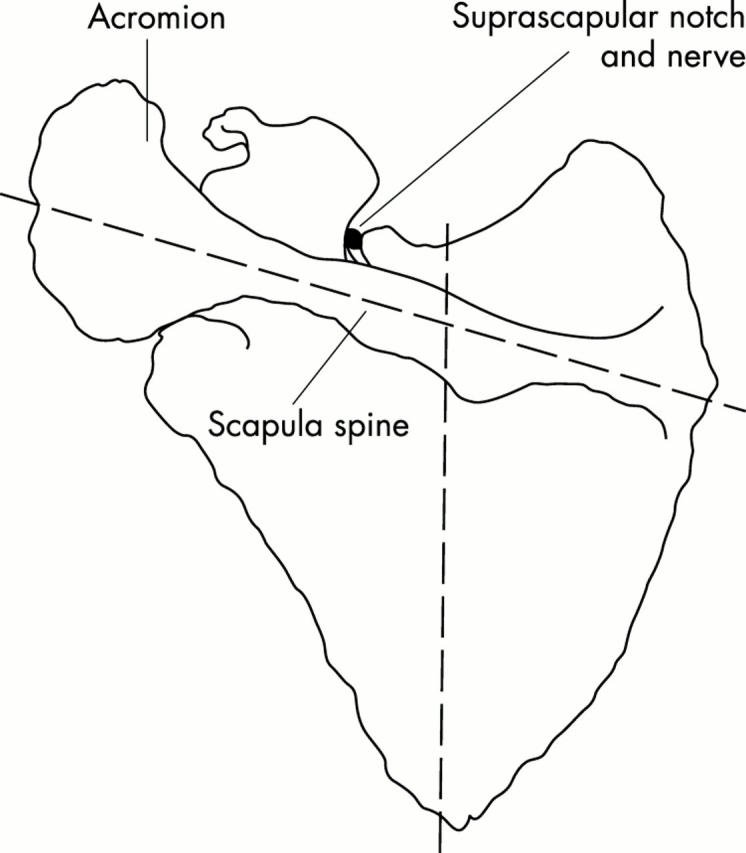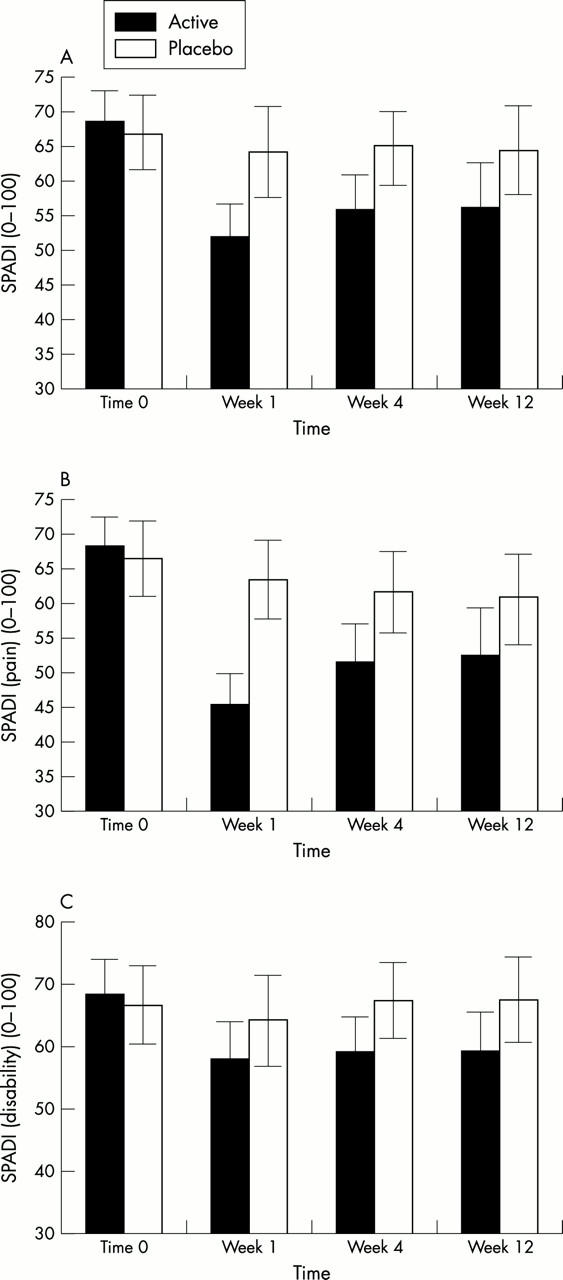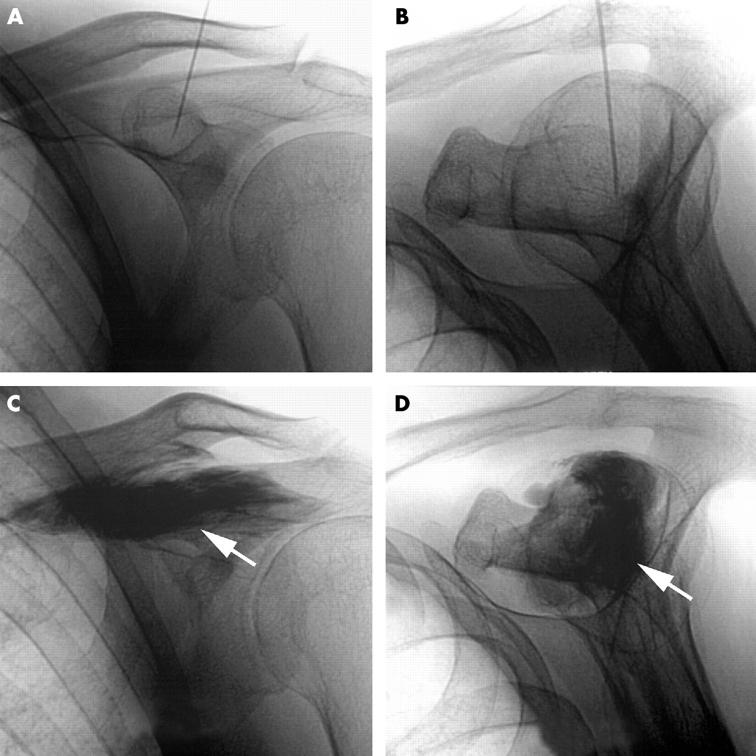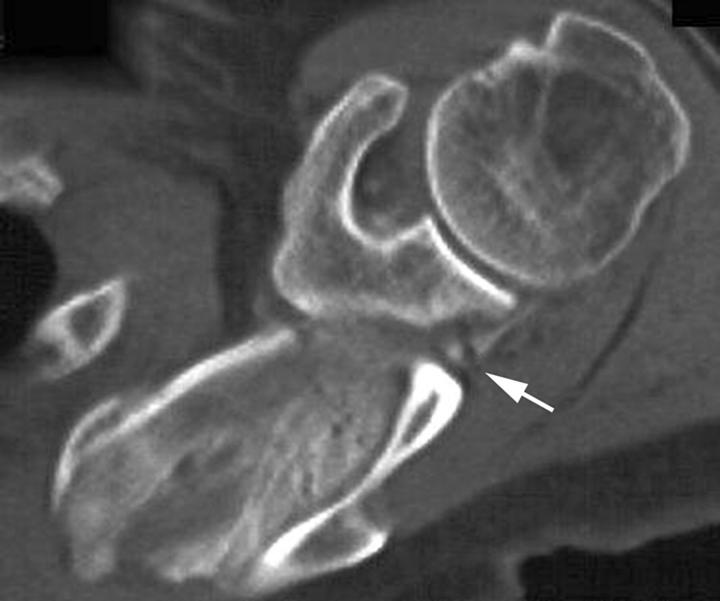Abstract
Background: Shoulder pain from inflammatory arthritis and/or degenerative disease is a common cause of morbidity in the community. It is difficult to treat and there are limited data on the efficacy of most interventions. Suprascapular nerve block has shown promise in limited trials in reducing shoulder pain. There have been no large randomised placebo controlled trials examining the efficacy of suprascapular nerve block for shoulder pain in arthritis and/or degenerative disease using pain and disability end points.
Objective: To perform a randomised, double blind, placebo controlled trial of the efficacy of suprascapular nerve block for shoulder pain in rheumatoid arthritis (RA) and/or degenerative disease of the shoulder.
Methods: 83 people with chronic shoulder pain from degenerative disease or RA took part in the trial. If a person had two painful shoulders, these were randomised separately. A total of 108 shoulders were randomised. Patients in the group receiving active treatment had a single suprascapular nerve block following the protocol described by Dangoisse et al, while those in the other group received a placebo injection of normal saline administered subcutaneously. The patients were followed up for 12 weeks by an observer who was unaware of the randomisation and reviewed at weeks 1, 4, and 12 after the injection. Pain, disability, and range of movement data were gathered.
Results: Clinically and statistically significant improvements in all pain scores, all disability scores, and some range of movement scores in the shoulders receiving suprascapular nerve block compared with those receiving placebo were seen at weeks 1, 4, and 12. There were no significant adverse effects in either group.
Conclusion: Suprascapular nerve block is a safe and efficacious treatment for the treatment of shoulder pain in degenerative disease and/or arthritis. It improves pain, disability, and range of movement at the shoulder compared with placebo. It is a useful adjunct treatment for the practising clinician to assist in the management of a difficult and common clinical problem.
Full Text
The Full Text of this article is available as a PDF (169.2 KB).
Figure 1.

Method of suprascapular nerve injection by identification of surface anatomy. With the patient seated, the spine of the scapula is identified. A perpendicular line is drawn from the angle of the scapula upward to bisect the spine of the scapula. About 2 cm lateral to the intersecting point, in the upper outer quadrant of the scapula, the needle is inserted to the hub of the needle or until the floor of the fossa is reached.
Figure 2.
Fluoroscopic image of the suprascapular nerve block injection. The needle is directed over the spine of the scapular and downward into the suprascapular fossa. (A) Anteroposterior view; (B) Neers view. Bupivacaine 10 ml and 1 ml (40 mg) of methylprednisolone is injected into the suprascapular fossa. For the purpose of illustration the injection material is mixed with contrast media. Arrows indicate the injected material. This material suffuses through the suprascapular fossa—(C) anteroposterior view; (D) Neers view.
Figure 3.
Computed tomographic scan of suprascapular fossa at the level of the suprascapular notch after a suprascapular nerve block mixed with contrast medium. The arrow illustrates the notch, through which runs the suprascapular nerve, bathed in contrast material.
Figure 4.

SPADI scores in the group receiving active treatment and placebo group at baseline and weeks 1, 4, and 12. (A) SPADI total scores; (B) SPADI pain subscale; (C) SPADI disability subscale. Values are mean scores and error bars are 95% confidence intervals.
Selected References
These references are in PubMed. This may not be the complete list of references from this article.
- Adebajo A. O., Nash P., Hazleman B. L. A prospective double blind dummy placebo controlled study comparing triamcinolone hexacetonide injection with oral diclofenac 50 mg TDS in patients with rotator cuff tendinitis. J Rheumatol. 1990 Sep;17(9):1207–1210. [PubMed] [Google Scholar]
- Arnett F. C., Edworthy S. M., Bloch D. A., McShane D. J., Fries J. F., Cooper N. S., Healey L. A., Kaplan S. R., Liang M. H., Luthra H. S. The American Rheumatism Association 1987 revised criteria for the classification of rheumatoid arthritis. Arthritis Rheum. 1988 Mar;31(3):315–324. doi: 10.1002/art.1780310302. [DOI] [PubMed] [Google Scholar]
- Brown D. E., James D. C., Roy S. Pain relief by suprascapular nerve block in gleno-humeral arthritis. Scand J Rheumatol. 1988;17(5):411–415. doi: 10.3109/03009748809105280. [DOI] [PubMed] [Google Scholar]
- Carette S. Adhesive capsulitis--research advances frozen in time? J Rheumatol. 2000 Jun;27(6):1329–1331. [PubMed] [Google Scholar]
- Chakravarty K. K., Webley M. Disorders of the shoulder: an often unrecognised cause of disability in elderly people. BMJ. 1990 Mar 31;300(6728):848–849. doi: 10.1136/bmj.300.6728.848-a. [DOI] [PMC free article] [PubMed] [Google Scholar]
- Croft P. Measuring up to shoulder pain. Ann Rheum Dis. 1998 Feb;57(2):65–66. doi: 10.1136/ard.57.2.65. [DOI] [PMC free article] [PubMed] [Google Scholar]
- Dangoisse M. J., Wilson D. J., Glynn C. J. MRI and clinical study of an easy and safe technique of suprascapular nerve blockade. Acta Anaesthesiol Belg. 1994;45(2):49–54. [PubMed] [Google Scholar]
- Emery P., Bowman S., Wedderburn L., Grahame R. Suprascapular nerve block for chronic shoulder pain in rheumatoid arthritis. BMJ. 1989 Oct 28;299(6707):1079–1080. doi: 10.1136/bmj.299.6707.1079. [DOI] [PMC free article] [PubMed] [Google Scholar]
- Gado K., Emery P. Modified suprascapular nerve block with bupivacaine alone effectively controls chronic shoulder pain in patients with rheumatoid arthritis. Ann Rheum Dis. 1993 Mar;52(3):215–218. doi: 10.1136/ard.52.3.215. [DOI] [PMC free article] [PubMed] [Google Scholar]
- Green S., Buchbinder R., Forbes A., Bellamy N. A standardized protocol for measurement of range of movement of the shoulder using the Plurimeter-V inclinometer and assessment of its intrarater and interrater reliability. Arthritis Care Res. 1998 Feb;11(1):43–52. doi: 10.1002/art.1790110108. [DOI] [PubMed] [Google Scholar]
- Green S., Buchbinder R., Glazier R., Forbes A. Systematic review of randomised controlled trials of interventions for painful shoulder: selection criteria, outcome assessment, and efficacy. BMJ. 1998 Jan 31;316(7128):354–360. doi: 10.1136/bmj.316.7128.354. [DOI] [PMC free article] [PubMed] [Google Scholar]
- Huskisson E. C. Measurement of pain. J Rheumatol. 1982 Sep-Oct;9(5):768–769. [PubMed] [Google Scholar]
- Lewis R. N. The use of combined suprascapular and circumflex (articular branches) nerve blocks in the management of chronic arthritis of the shoulder joint. Eur J Anaesthesiol. 1999 Jan;16(1):37–41. doi: 10.1046/j.1365-2346.1999.00401.x. [DOI] [PubMed] [Google Scholar]
- Naredo E., Aguado P., De Miguel E., Uson J., Mayordomo L., Gijon-Baños J., Martin-Mola E. Painful shoulder: comparison of physical examination and ultrasonographic findings. Ann Rheum Dis. 2002 Feb;61(2):132–136. doi: 10.1136/ard.61.2.132. [DOI] [PMC free article] [PubMed] [Google Scholar]
- Nørregaard J., Krogsgaard M. R., Lorenzen T., Jensen E. M. Diagnosing patients with longstanding shoulder joint pain. Ann Rheum Dis. 2002 Jul;61(7):646–649. doi: 10.1136/ard.61.7.646. [DOI] [PMC free article] [PubMed] [Google Scholar]
- Parris W. C. Suprascapular nerve block: a safer technique. Anesthesiology. 1990 Mar;72(3):580–581. doi: 10.1097/00000542-199003000-00041. [DOI] [PubMed] [Google Scholar]
- Petersson C. J. Painful shoulders in patients with rheumatoid arthritis. Prevalence, clinical and radiological features. Scand J Rheumatol. 1986;15(3):275–279. doi: 10.3109/03009748609092592. [DOI] [PubMed] [Google Scholar]
- Petri M., Dobrow R., Neiman R., Whiting-O'Keefe Q., Seaman W. E. Randomized, double-blind, placebo-controlled study of the treatment of the painful shoulder. Arthritis Rheum. 1987 Sep;30(9):1040–1045. doi: 10.1002/art.1780300911. [DOI] [PubMed] [Google Scholar]
- Pope D. P., Croft P. R., Pritchard C. M., Silman A. J. Prevalence of shoulder pain in the community: the influence of case definition. Ann Rheum Dis. 1997 May;56(5):308–312. doi: 10.1136/ard.56.5.308. [DOI] [PMC free article] [PubMed] [Google Scholar]
- Ritchie E. D., Tong D., Chung F., Norris A. M., Miniaci A., Vairavanathan S. D. Suprascapular nerve block for postoperative pain relief in arthroscopic shoulder surgery: a new modality? Anesth Analg. 1997 Jun;84(6):1306–1312. doi: 10.1097/00000539-199706000-00024. [DOI] [PubMed] [Google Scholar]
- Roach K. E., Budiman-Mak E., Songsiridej N., Lertratanakul Y. Development of a shoulder pain and disability index. Arthritis Care Res. 1991 Dec;4(4):143–149. [PubMed] [Google Scholar]
- Vecchio P. C., Adebajo A. O., Hazleman B. L. Suprascapular nerve block for persistent rotator cuff lesions. J Rheumatol. 1993 Mar;20(3):453–455. [PubMed] [Google Scholar]
- Williams J. W., Jr, Holleman D. R., Jr, Simel D. L. Measuring shoulder function with the Shoulder Pain and Disability Index. J Rheumatol. 1995 Apr;22(4):727–732. [PubMed] [Google Scholar]
- Woolf C. J. Somatic pain--pathogenesis and prevention. Br J Anaesth. 1995 Aug;75(2):169–176. doi: 10.1093/bja/75.2.169. [DOI] [PubMed] [Google Scholar]
- de Winter A. F., Jans M. P., Scholten R. J., Devillé W., van Schaardenburg D., Bouter L. M. Diagnostic classification of shoulder disorders: interobserver agreement and determinants of disagreement. Ann Rheum Dis. 1999 May;58(5):272–277. doi: 10.1136/ard.58.5.272. [DOI] [PMC free article] [PubMed] [Google Scholar]
- van der Heijden G. J., van der Windt D. A., Kleijnen J., Koes B. W., Bouter L. M. Steroid injections for shoulder disorders: a systematic review of randomized clinical trials. Br J Gen Pract. 1996 May;46(406):309–316. [PMC free article] [PubMed] [Google Scholar]
- van der Windt D. A., van der Heijden G. J., Scholten R. J., Koes B. W., Bouter L. M. The efficacy of non-steroidal anti-inflammatory drugs (NSAIDS) for shoulder complaints. A systematic review. J Clin Epidemiol. 1995 May;48(5):691–704. doi: 10.1016/0895-4356(94)00170-u. [DOI] [PubMed] [Google Scholar]




